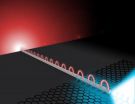(Press-News.org) A new combination of materials can efficiently guide electricity and light along the same tiny wire, a finding that could be a step towards building computer chips capable of transporting digital information at the speed of light.
Reporting today in The Optical Society's (OSA) high-impact journal Optica, optical and material scientists at the University of Rochester and Swiss Federal Institute of Technology in Zurich describe a basic model circuit consisting of a silver nanowire and a single-layer flake of molybendum disulfide (MoS2).
Using a laser to excite electromagnetic waves called plasmons at the surface of the wire, the researchers found that the MoS2 flake at the far end of the wire generated strong light emission. Going in the other direction, as the excited electrons relaxed, they were collected by the wire and converted back into plasmons, which emitted light of the same wavelength.
"We have found that there is pronounced nanoscale light-matter interaction between plasmons and atomically thin material that can be exploited for nanophotonic integrated circuits," said Nick Vamivakas, assistant professor of quantum optics and quantum physics at the University of Rochester and senior author of the paper.
Typically about a third of the remaining energy would be lost for every few microns (millionths of a meter) the plasmons traveled along the wire, explained Kenneth Goodfellow, a graduate student at Rochester's Institute of Optics and lead author of the Optica paper.
"It was surprising to see that enough energy was left after the round-trip," said Goodfellow.
Photonic devices can be much faster than electronic ones, but they are bulkier because devices that focus light cannot be miniaturized nearly as well as electronic circuits, said Goodfellow. The new results hold promise for guiding the transmission of light, and maintaining the intensity of the signal, in very small dimensions.
Ever since the discovery of graphene, a single layer of carbon that can be extracted from graphite with adhesive tape, scientists have been rapidly exploring the world of two-dimensional materials. These materials have unique properties not seen in their bulk form.
Like graphene, MoS2 is made up of layers that are weakly bonded to each other, so they can be easily separated. In bulk MoS2, electrons and photons interact as they would in traditional semiconductors like silicon and gallium arsenide. As MoS2 is reduced to thinner and thinner layers, the transfer of energy between electrons and photons becomes more efficient.
The key to MoS2's desirable photonic properties is in the structure of its energy band gap. As the material's layer count decreases, it transitions from an indirect to direct band gap, which allows electrons to easily move between energy bands by releasing photons. Graphene is inefficient at light emission because it has no band gap.
Combining electronics and photonics on the same integrated circuits could drastically improve the performance and efficiency of mobile technology. The researchers say the next step is to demonstrate their primitive circuit with light emitting diodes.
INFORMATION:
Paper: K. Goodfellow, R. Beams, C. Chakraborty, L. Novotny, A.N. Vamivakas "Integrated nanophotonics based on nanowire plasmons and atomically-thin material" Optica Vol. 1, Issue 3, pp.149-152 (2014).
About the University of Rochester
The University of Rochester is one of the nation's leading private universities. Located in Rochester, N.Y., the University gives students exceptional opportunities for interdisciplinary study and close collaboration with faculty through its unique cluster-based curriculum. Its College, School of Arts and Sciences, and Hajim School of Engineering and Applied Sciences are complemented by its Eastman School of Music, Simon School of Business, Warner School of Education, Laboratory for Laser Energetics, School of Medicine and Dentistry, School of Nursing, Eastman Institute for Oral Health, and the Memorial Art Gallery.
Atomically thin material opens door for integrated nanophotonic circuits
2014-09-04
ELSE PRESS RELEASES FROM THIS DATE:
Trinity geologists re-write Earth's evolutionary history books
2014-09-04
Geologists from Trinity College Dublin have rewritten the evolutionary history books by finding that oxygen-producing life forms were present on Earth some 3 billion years ago – a full 60 million years earlier than previously thought. These life forms were responsible for adding oxygen (O2) to our atmosphere, which laid the foundations for more complex life to evolve and proliferate.
Working with Professors Joydip Mukhopadhyay and Gautam Ghosh and other colleagues from the Presidency University in Kolkata, India, the geologists found evidence for chemical weathering of ...
Study: Oxidized LDL might actually be 'good guy'
2014-09-04
LEXINGTON, Ky (Sept. 4, 2014) -- A team of investigators at the University of Kentucky has made a thought-provoking discovery about a type of cholesterol previously believed to be a "bad guy" in the development of heart disease and other conditions.
Jason Meyer, a University of Kentucky MD-PhD candidate, worked with Deneys van der Westhuyzen, Ph.D., a Professor in the Departments of Internal Medicine and Molecular and Cellular Biochemistry, to study the role oxidized LDL plays in the development of plaque inside artery walls.
According to Meyer, the medical research ...
Research shows declining levels of acidity in Sierra Nevada lakes
2014-09-04
RIVERSIDE, Calif. — California's water supply depends on a clean snow pack and healthy mountain lakes. The lakes receive a large amount of runoff in the spring from the melting snowpack. If the snowpack is polluted, the lakes will be polluted.
James O. Sickman, an environmental scientist at the University of California, Riverside, has conducted research on lakes in the Sierra Nevada—the most sensitive lakes in the U.S. to acid rain, according to the Environmental Protection Agency—and described human impacts on them during the 20th century. The research was done by ...
New research offers help for spinal cord patients
2014-09-04
Many patients suffer from severe spinal cord injuries after being involved in traffic accidents or accidents at work. An injury to the spinal cord is a catastrophe for the individual, and often results in complete or partial paralysis of the person's arms and legs. Despite the paralysis, several patients experience problems with involuntary muscle contractions or spasms which impair the patient's quality of life.
The movements are due to the neurotransmitter serotonin, which normally plays a crucial role in relation to our voluntary control of movements by reinforcing ...
Mantle plumes crack continents
2014-09-04
In some parts of the Earth, material rises upwards like a column from the boundary layer of the Earth's core and the lower mantel to just below the Earth's crust hundreds of kilometres above. Halted by the resistance of the hard crust and lithospheric mantle, the flow of material becomes wider, taking on a mushroom-like shape. Specialists call these magma columns "mantle plumes" or simply "plumes".
Are mantel plumes responsible for the African rift system?
Geologists believe that plumes are not just responsible for creating volcanoes outside of tectonically active areas ...
Implact of dexamethasone on intelligence and hearing in preterm infants
2014-09-04
Glucocorticoids are speculated to have a long-term impact on the development of the nervous system and increase the incidence of cerebral palsy in preterm infants. The existing studies concerning the role of dexamethasone in preterm infants are insufficiently reliable owing to short follow-up periods and small sample sizes in clinical studies, or the absence of randomized controlled trials. Ruolin Zhang and co-workers from the Second Xiangya Hospital, Central South University in China conducted a meta-analysis of 10 relevant randomized controlled trials. They found that ...
Apolipoprotein E and apolipoprotein CI are involved in cognitive impairment progression in Chinese late-onset Alzheimer's disease
2014-09-04
Current evidence shows that apolipoprotein E (APOE), apolipoprotein CI (APOC1) and low density lipoprotein receptor-related protein (LRP) variations are related to late-onset Alzheimer's disease. However, it remains unclear if genetic polymorphisms in these genes are associated with cognitive decline in late-onset Alzheimer's disease patients. According to a recent study reported in the Neural Regeneration Research, APOE ε4 plays an important role in augmenting cognitive decline, and APOC1 H2 may act synergistically with APOE ε4 in increasing the risk of cognitive ...
Cystic fibrosis: Additional immune dysfunction discovered
2014-09-04
Cystic fibrosis (mucoviscidosis) is due to a mutation of an ion channel which leads to highly viscous mucus and to dysfunction of the lung and the gastrointestinal organs. Since these patients frequently suffer from chronic infections, Dr. Thomas Hofer and Professor Dr. Loems Ziegler-Heitbrock from the Comprehensive Pneumology Center (CPC) at Helmholtz Zentrum München - together with colleagues at the Klinikum der Universität München and the University of Leicester, UK - investigated, whether these patients might have an additional immune defect. The scientists found ...
Finding new approaches for therapeutics against Ebola virus
2014-09-04
Researchers from the University of Liverpool in collaboration with Public Health England have been investigating new ways to identify drugs that could be used to treat Ebola virus infection.
Their approach has been to study what proteins inside a cell are critical for the functions of Ebola virus and are hijacked by the virus to help with infection. One of the proteins they have targeted is known as VP24. This protein disrupts signalling in infected human cells and disrupts the body's immune system and the fight against the virus.
Once the team identified these cellular ...
Bats change strategy when food is scarce
2014-09-04
Echolocating bats have historically been classified into two groups: 'loud' aerial hawkers who catch flying insects on the wing and 'whispering' gleaners that pick up prey from the ground. While some bat species can forage in multiple ways, others have limited flexibility in the amplitude of their echolocation calls.
Dr Talya Hackett and colleagues studied the desert long-eared bat (Otonycteris hemprichii), said to be a passive 'whispering' gleaner that picks up ground-dwelling invertebrates, such as scorpions, from the desert floor.
Using an acoustic tracking system, ...


